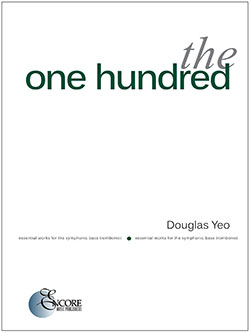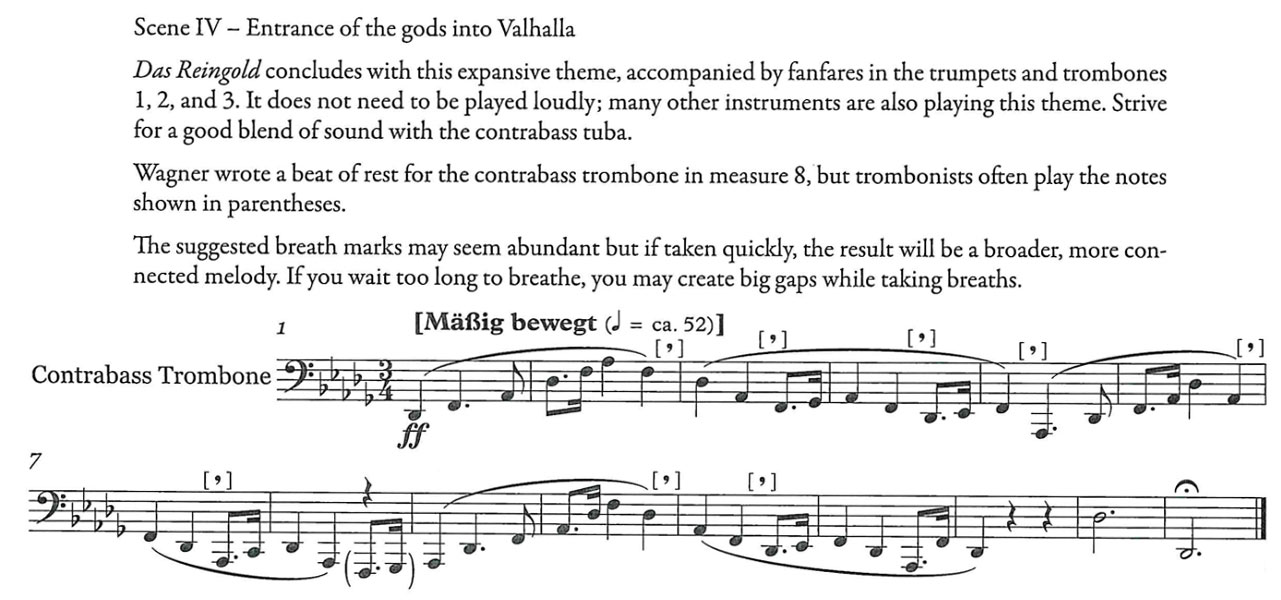The One Hundred: Essential Works for the Symphonic Bass Trombonist: A Review
 Yeo, Douglas. The One Hundred: Essential Works for the Symphonic Bass Trombonist. Encore Music Publishers, Maple City, MI, 2017. 266 pages, spiral bound. ISBN 978-1532331459.
Yeo, Douglas. The One Hundred: Essential Works for the Symphonic Bass Trombonist. Encore Music Publishers, Maple City, MI, 2017. 266 pages, spiral bound. ISBN 978-1532331459.
Douglas Yeo is well known not only for his career with the Boston Symphony Orchestra but also for his contributions as a scholar and teacher. He begins by asking the reader, "Why another orchestral excerpt book?" He goes on to list some excellent reasons. On top of giving expert advice for each passage, players looking for a place to focus their efforts will benefit by having this resource readily available. This book is part of a series including volumes by Megumi Kanda (tenor trombone) and Wesley Jacobs (tuba). Mr. Yeo has compiled "what my experience has told me are the most important works that are likely to come across a player's music stand at an audition or performance."
Where to begin? When the review copy of this book reached me, I was a few days away from going on tour as a substitute bass trombonist with The Utah Symphony. A quick look at the program showed that three of the tour pieces were covered in The One Hundred: Holst's The Planets, Tchaikovsky's 1812 Overture, and Bizet's "Farandole" from L'Arlésienne Suite. Reading through these sections gave me an instant sense of the value of this excerpt book.
Organized in alphabetical order, each entry begins with an illustration of the composer along with two or three paragraphs of biographical information. Specific information is provided for each selected excerpt along with clean and attractively printed musical passages. For Holst's Jupiter, there are several good pieces of advice including places to try breathing, as well as an insider's bass trombone trick. For a difficult sixteenth-note arpeggio, this advice is given: "Holst did not include the G-natural sixteenth-note in measure 266 because it was virtually impossible to play the interval G to A on a G bass trombone (first to sixth position) in this fast tempo. Today, players usually play this G, as notated below in the ossia measure, which makes entering on-time easier."

Encore Music Publishers has generously provided a PDF of the Holst entry (pages 101-103) as a sample of the book's format including the composer information, instructional text and musical excerpts.
This tip led me to check on the excerpt for Wagner's "Entry of the gods into Valhalla" from Das Reingold. In this passage, Mr. Yeo provides notes that do not appear in the original contrabass trombone part, but which are normally played. Together with excellent advice on dynamics, blend, and possible breathing strategies, this Wagner entry is another example of the thorough approach taken in this book.

Tempo markings are given in three different ways: "Tempi that are printed without square brackets are given by the composer at the point in the piece where the excerpt begins. Tempi in square brackets are the composer's most recent tempo indicated in the piece, and metronome markings with the indication ca. (circa) are my own since the composer gives none." Having specific tempi in mind is essential in preparing any excerpt. Listening to recordings is always a good idea, and as Mr. Yeo advocates practicing "everything 10% faster, slower, louder, and softer than you think is right so you are ready for anything a conductor might ask of you."
The list of music included in this volume is expansive. Back to tour preparation, the only thing I didn't find in this book was a representation of the music of John Williams. Star Wars: Main Title seems to show up frequently in the concert hall, but what to leave out in that case? (Maybe a collection of John Williams trombone parts would be a good stand-alone project.) Any excerpt book needs to have limits, and the 100 passages selected by Mr. Yeo are ideal as they are. Copyrights have been secured for everything in this book, making this a legal source for excerpts not in the public domain.
There are many practical tips throughout the book. Teachers who are more familiar with tenor trombone excerpts or who are looking for a reliable source of information they can share with their bass trombone students are sure to benefit from owning a copy of The One Hundred. "Why another orchestral excerpt book?" The answer is that Douglas Yeo has provided an outstanding resource for the trombone community. Serious students and teachers will enjoy using this book as they "leave no stone unturned in their preparation."
